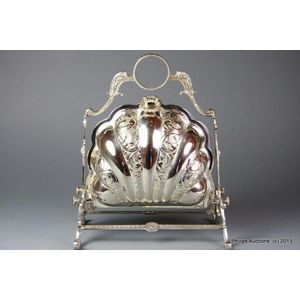Victorian Silverplated Biscuit Sachet
You must be a subscriber, and be logged in to view price and dealer details.
Subscribe Now to view actual auction price for this item
When you subscribe, you have the option of setting the currency in which to display prices to $Au, $US, $NZ or Stg.
- Embossed / Repousse - Embossing, also known as repousse, is the technique of decorating metal with raised designs, by pressing or beating out the design from the reverse side of the object.It is the opposite of chasing, where the decoration is applied from the front. An embossed or repoussed object may have chasing applied to finish off the design.
- Victorian Period - The Victorian period of furniture and decorative arts design covers the reign of Queen Victoria from 1837 to 1901. There was not one dominant style of furniture in the Victorian period. Designers used and modified many historical styles such as Gothic, Tudor, Elizabethan, English Rococo, Neoclassical and others, although use of some styles, such as English Rococo and Gothic tended to dominate the furniture manufacture of the period.
The Victorian period was preceded by the Regency and William IV periods, and followed by the Edwardian period, named for Edward VII (1841 ? 1910) who was King of the United Kingdom and the British Dominions and Emperor of India for the brief period from 1901 until his death in 1910. - Scallop / Shell Motif - The shell motif has been used in furniture and decorative arts for centuries. In ancient Greece and Rome, shells were often used as decorative elements on furniture and in mosaics. The scallop or cockleshell are the most commonly used. During the Renaissance, the shell motif became popular in furniture and architecture, as the ornate decoration was seen as a symbol of wealth and luxury. In the 18th century, the Rococo style of furniture and decorative arts featured an abundance of shell motifs, and it was used by Thomas Chippendale and as a feature on Queen Anne style cabriole legs. In the 19th century, the shell motif was incorporated into Victorian furniture and decorative items, and often a representation of the the conch shell was inlaid into furniture.
This item has been included into following indexes:
Visually similar items

Edwardian silver plate folding biscuit box, two sections opening to internal grills. Embossed decoration. Engraved dedication dated 1901. Marked 'L & Co' to base, height 16 cm

An Indian bronze Jain shrine, probably 20th century, 24 cm high

An impressive c.1800 French 'Lyre' ormolu and marble mantel clock, the tall clock with main Lyre form body framing the circular porcelain ormolu cased dial, Roman numerals with seconds dial to the exterior and day of the month to the interior, surmounted b

A fine French rococo style gilt bronze clock garniture, 19th century, the base of dial inscribed by the founder Alfred Daubree a Nancy (1817-1885), each candelabrum with eight lights, the clock 68 cm high and the candelabra 83 cm high
